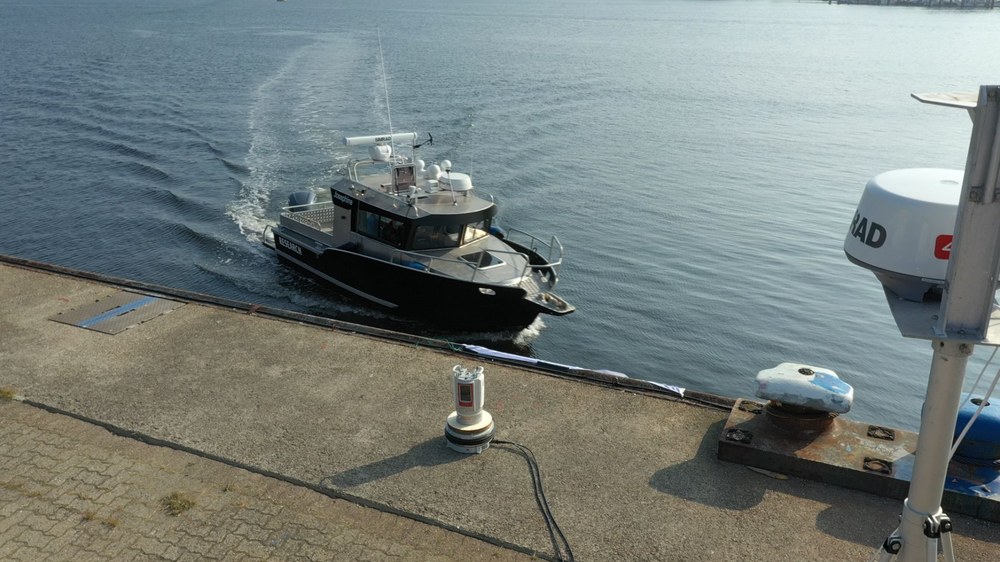HAGGIS and LABSKAUS ensure greater safety at sea



- DLR is testing highly automated assistance systems and concepts for autonomous ships.
- The eMIR maritime testbed enables SMEs and research institutes to test new technology developments under simulated and real-world conditions.
- Focus: Transport, maritime assistance systems, autonomous shipping
The e-Maritime Integrated Reference Platform (eMIR) testbed is helping to make shipping safer and more efficient. As a reference maritime testbed, eMIR offers industry, small and medium-sized enterprises and research institutes the opportunity to study and develop highly automated assistance systems and concepts for autonomous ships. eMIR is operated and being continuously developed by the German Aerospace Center (Deutsches Zentrum für Luft- und Raumfahrt; DLR) Institute of Systems Engineering for Future Mobility in collaboration with the OFFIS Institute for Information Technology.
"Due to the growing global volume of shipping traffic, autonomous and automated systems are becoming increasingly important. Assistance systems can support ship and port personnel in avoiding damage to ships and their cargo, harm to the natural environment and, above all, personal injury," explains Anke Kaysser-Pyzalla, Chair of the DLR Executive Board. "To this end, DLR’s maritime research team is investigating the use of highly automated systems for greater safety and economic efficiency. This includes technologies for navigation and communications that can be tested, verified and validated using the eMIR testbed."
"Digitalisation is making an important contribution to shaping future mobility," adds Axel Hahn, Director of the DLR Institute of Systems Engineering for Future Mobility. "Today, we have sensor and actuator systems with AI-based functions available for this purpose. Our testbed is an environment in which we can assess and validate new technologies to ensure that they will assist their future users safely and reliably."
Focus on technology development and validation
Researchers begin by collecting specific data on shipping movements and environmental conditions. This allows them to draw conclusions regarding how often certain situations arise, and the kinds of conditions under which they occur. "This is important information for designing future assistance systems in such a way that they will be able to provide their users with recommendations for action," explains Hahn. eMIR offers a platform for the development of methods and technologies and for the verification and validation of systems. One example of an assistance system is a 'parking assist' function – as already exists in the automotive sector – developed for ship pilots. Ship personnel and pilots on the bridge are shown data on a tablet or through VR glasses. This supports them in harbour and channel areas where visibility may be restricted during docking and casting-off manoeuvres. In this way, it is possible to prevent damage to the ships themselves, the port infrastructure and the environment – and avoid accidents involving personal injury.
Simulation of maritime traffic
The testbed comprises two parts – a simulation-based system and a real-world test environment at sea. The HAGGIS virtual co-simulation infrastructure includes AI-based environmental, traffic and ship simulators. With their help, the risks and the efficiency of innovative maritime systems can be assessed while the product is being developed. In this safe simulation environment, systems for avoiding collisions, for example, can be tested without exposing persons or property to genuine risk. In addition, simulation-based tests are much more cost effective.
Testing under real-world maritime conditions
In parallel with the HAGGIS system, the LABSKAUS physical testbed allows maritime systems to then be assessed under real-world conditions. The sea area from Brunsbüttel past Cuxhaven and Wilhelmshaven to Heligoland has been equipped with instrumentation for this purpose. The incremental method for testing automated system functions promises meaningful results, lower costs and significantly lower risks. Hardware and simulations can also be combined while at sea. A complete ship's bridge, installed in a seagoing container, can be set up at the harbour, or loaded on board a ship. It can be used to carry out on-site experiments in port or at sea. In addition to radar and artificial intelligence, this bridge also uses camera- and laser-based sensors. DLR also has its own experimental boat, the research vessel Josephine. This craft serves as a sensor platform but can also be fully remote controlled. It thus offers an ideal test environment for highly automated navigational functions in the maritime sector.
The evolution of eMIR has benefited from long-term cooperation with partners from research, industry and public authorities, in particular the German Federal Maritime and Hydrographic Agency (Bundesamt für Seeschifffahrt und Hydrographie; BSH). At DLR, the maritime test bed is being planned and further developed under the leadership of the Institute of Systems Engineering for Future Mobility. The DLR institutes of Transportation Systems and Communications and Navigation, together with the Institute for the Protection of Maritime Infrastructures are also contributing their skills and expertise to the project.
One of the world's largest integrated testbeds for multi-modal freight transport is being created in conjunction with the DLR's Lower Saxony Test Field for the automotive industry.
